Above: Stoke signal box at 12 noon on 22nd June 1961. An Up express from Leeds to London is hauled by King's Cross based class A3 No. 60109 Hermit. Photograph taken by Noel Ingram.
by Derek Steptoe
Probably the worst thing about Stoke box was the poor access, with no roads near it for around two miles. There were four ways to reach it:
- Use a rough road through a farmyard and across fields.
- On foot through the tunnel, after leaving your car at Highdyke; not for the faint hearted!!
- Walk over the tunnel; not for the unfit!!
- Catch a light engine or a slow goods train at Grantham.
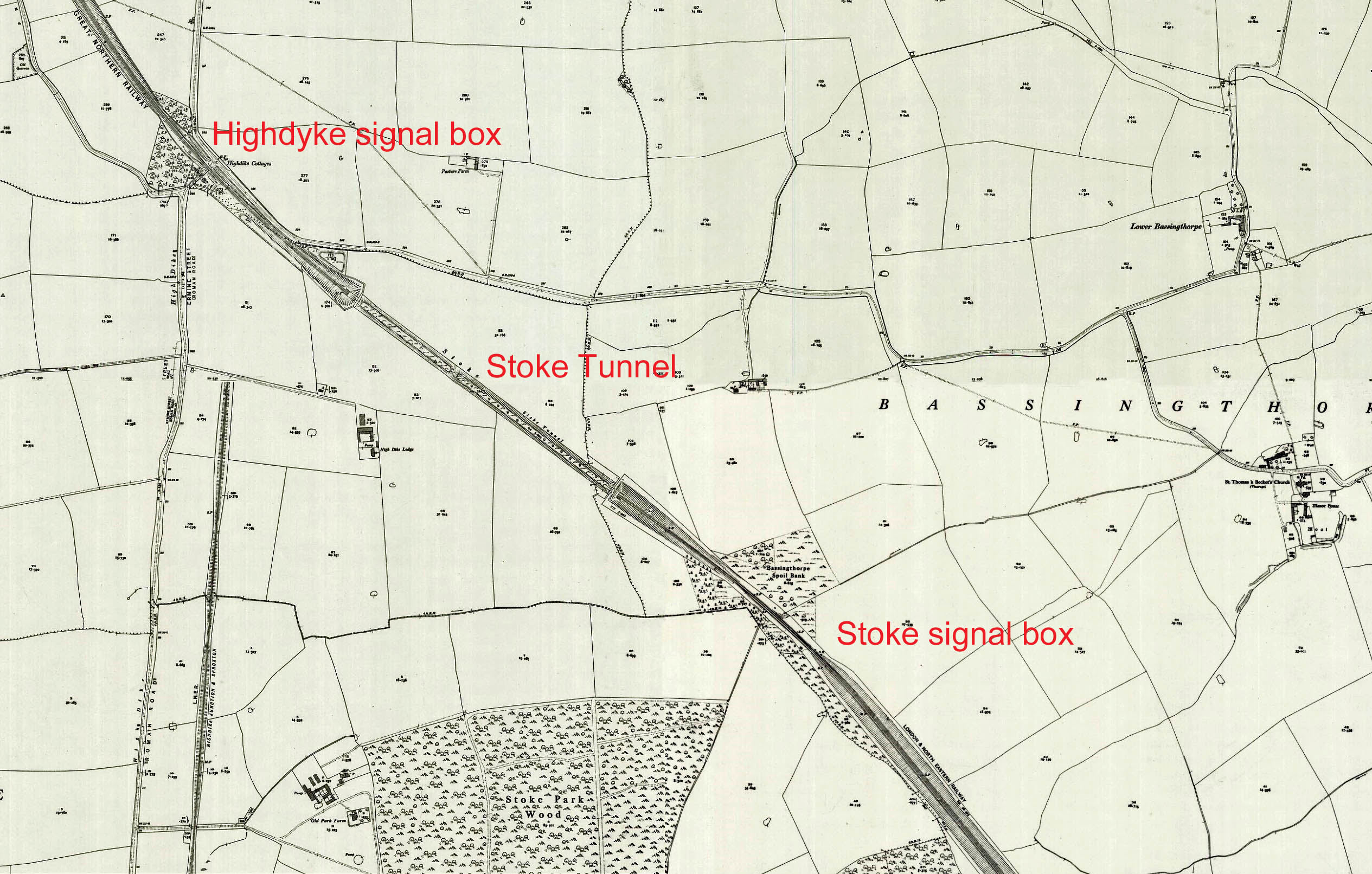
Note: this map has been compiled from sheets of different dates, so the branch to Stainby from Highdyke is only partly shown.
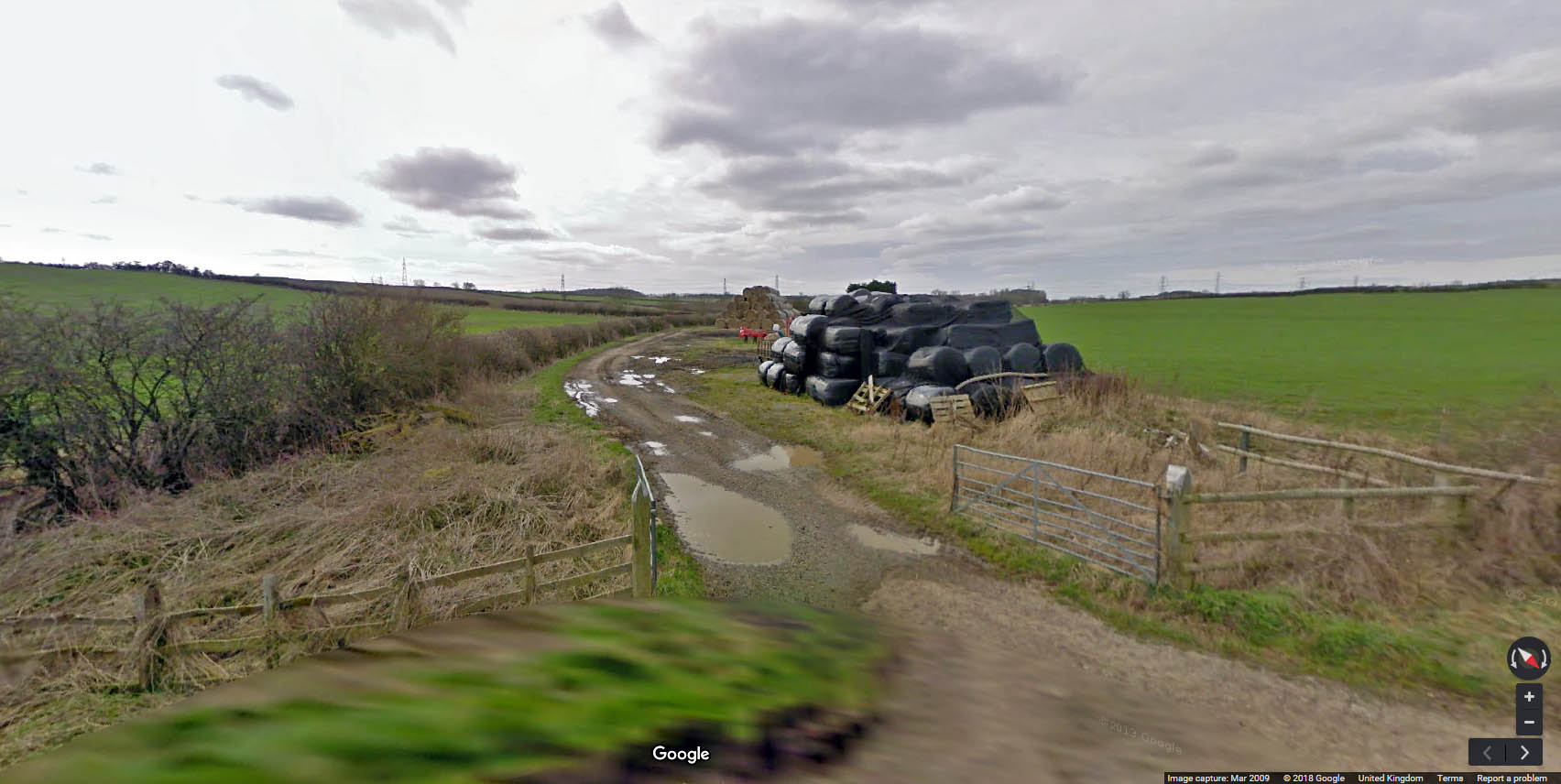
The box had no running water so we had to use it sparingly . We sometimes took our own water or relied on light engines to bring some. We also had the pleasure of an Elsan toilet, emptied by the Sunday shift - don't forget your spade. There was no electric light, which meant the smell of paraffin 24 hours a day and the noise of the flame at night, not to mention the moths. The strange thing was that there was a very welcome Belling electric cooker.

Many Great Northern Railway signal boxes had intricately pierced wooden barge boards and prominent roof end finials - even at remote locations such as Stoke, where very few people would have the opportunity to admire these architectural flourishes unless they worked on the railway locally. The decoration extends to the end of the roof of the closet on the landing, wherein resided the Elsan chemical toilet. At the south end a tank collects rainwater from the roof.
Photograph by Mike Mather.
It was a very lonely box to work, and the only person you saw regularly was the lampman who visited twice a week. His name was Geeson. He pushed his bike down the cess from Corby to do their lamps and then Stoke's. He would never accept a cuppa and sat in the lamproom to eat his lunch, a brick building just north of the box that had no door, windows or heating by the time I worked at Stoke!! Between the box and the lamp cabin was an open wooden place where our coal was kept.

Photograph by Alan Curtis

Photograph by Alan Curtis
The Up distant had been moved to the north of the tunnel by the time I worked there, and it was a colour light signal. Highdyke box decided which trains were diverted into the Up slow. As per rule book diverted trains were brought quite or nearly to a stand before the home board was pulled off. Memory’s not quite what it was but I think the bell signal was 1-5-5, 'shunt train for following train to pass'.
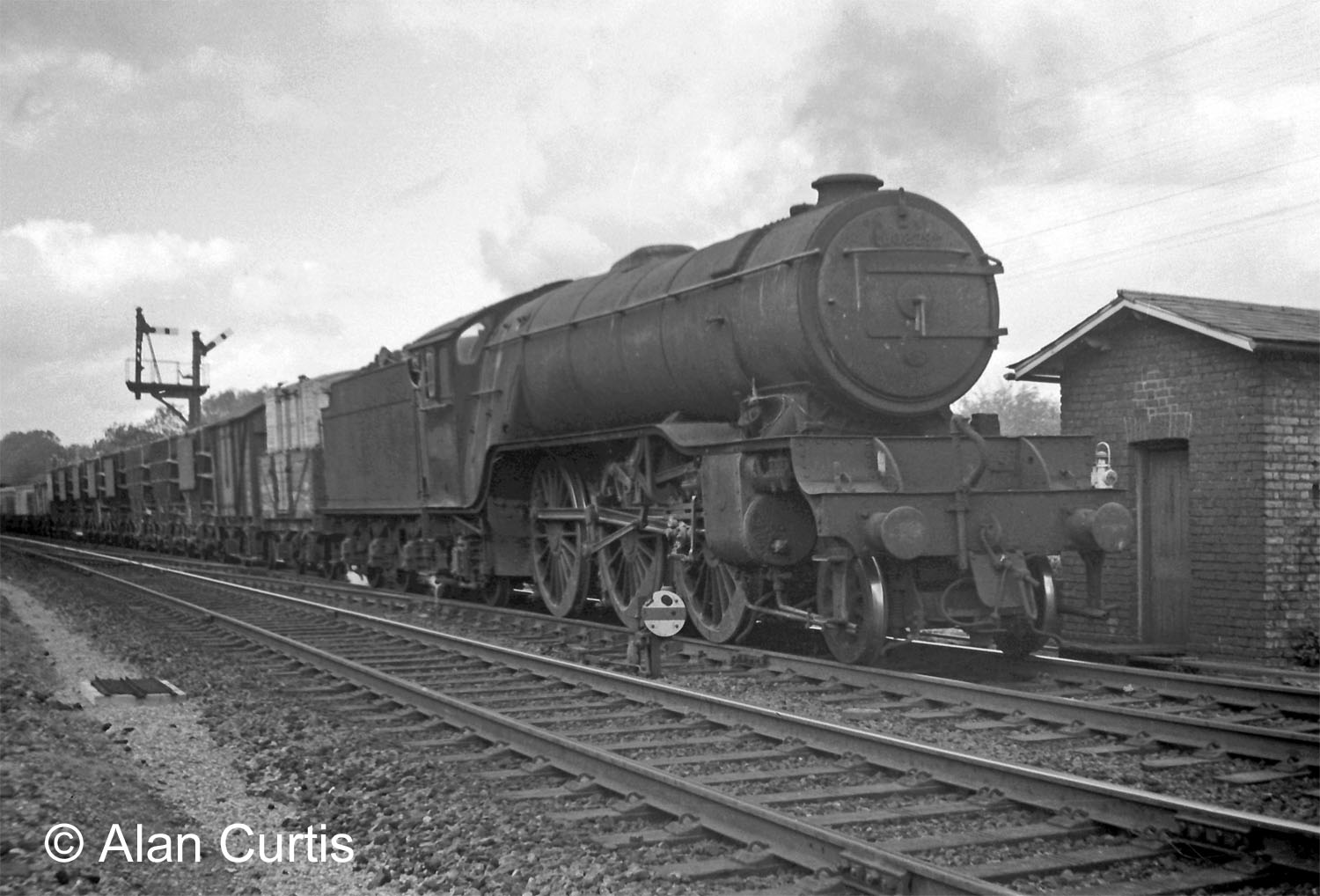
Photograph by Alan Curtis
The Down slow home was almost opposite the box and some trains were held for quite a time, so sometimes driver and fireman would come over for a chat and a cuppa. I think Stoke came under Peterborough for supervision, certainly the DI's (District Inspectors) were from there. My eldest brother Terry also worked this box as he was a rest day relief, also my father Albert who was general relief and later Yard Inspector at Highdyke.
A view from the box:
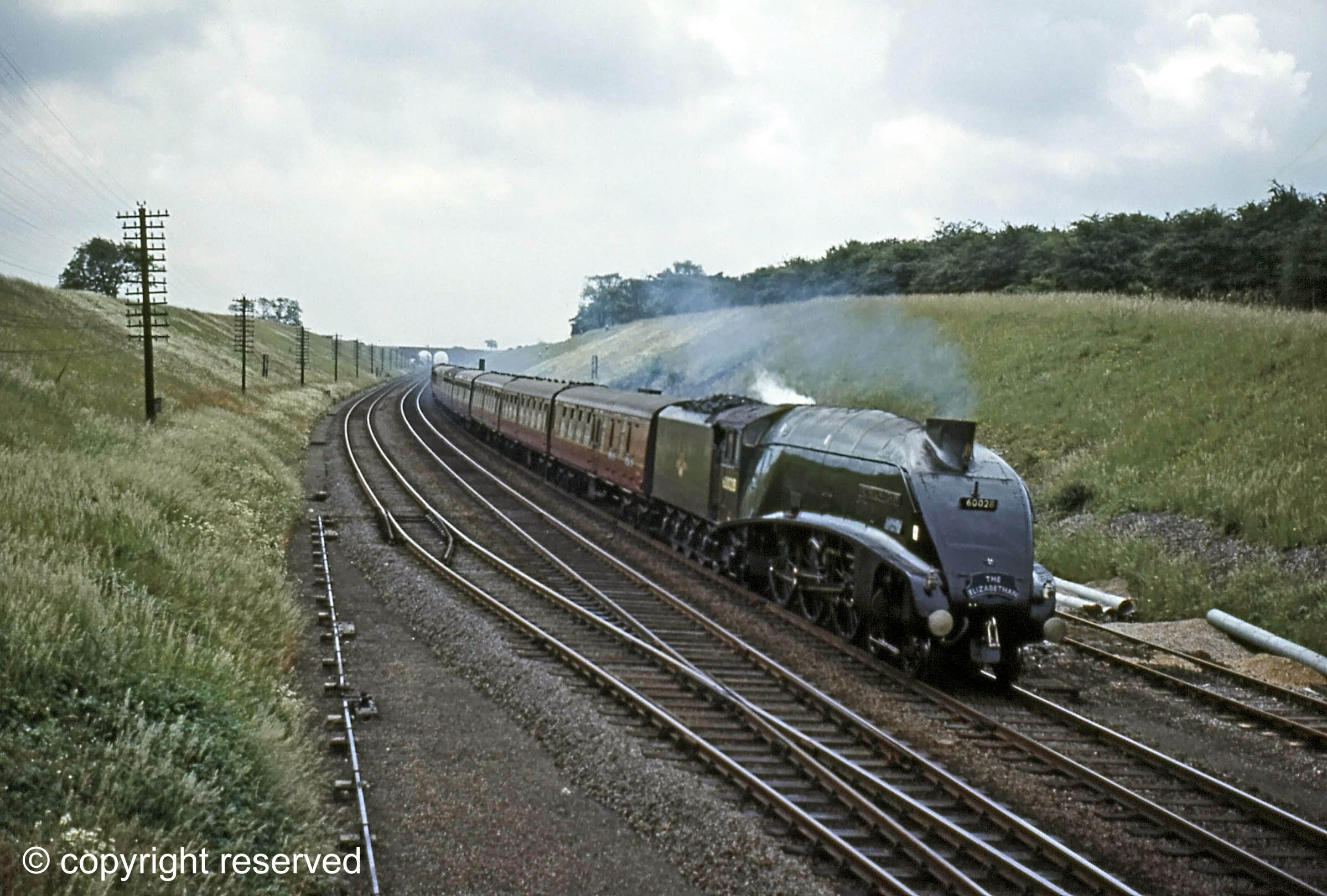
In the foreground the Up Goods line diverges to the left from the Up Main line.
In the background, on the far side of the cutting and above the second coach, a gang of men are cutting the lush grass by hand.
Photograph taken by Noel Ingram.
Stoke Box: interior photographs by Mike Mather, 1974
There are so many photos of locomotives and trains, yet so few of signal boxes other than as background features. Thankfully Mike decided to make a record, in colour, of the boxes to the south of Grantham when their closure was imminent.

Some of the semaphore signals seen in the 1961 photographs below had been replaced with colour light signals by this time.
Photograph by Mike Mather

Beyond the far end of the frame we get a glimpse of that vital piece of equipment - the Belling electric cooker!
Photograph by Mike Mather

Below the block instruments, and above some of the signal levers, are circular indicators which inform the signalman of the position of the signal worked by that lever. This is so he can be sure the signal is reponding correctly, because some signals are out of sight from the box.
Photograph by Mike Mather.

The main instruments from left to right are:
o LNER type block telegraph instrument and bell for Up and Down Main Lines to Corby Glen to the south (black);
o the Block Switch, used for 'switching out' Stoke box when the junctions at Stoke were not required and Stoke box was not staffed; when set to 'OUT' its contacts put Higdyke and Corby Glen boxes into direct communication (varnished wood)
o LNER type block telegraph instrument for Down and Up Main Lines to Highdyke to the north (black);
o block bell for Highdyke (varnished wood)
Three green warning detonators hang from the front of the shelf.
At far left is a battery-powered Bardic signalling lamp, sucessor to the oil lamps in use until the 1960s.
Photograph by Mike Mather.
Stoke Signal Cabin - a brief history
The locality derives its name from the nearby village of Stoke Rochford, adjacent to the Great North Road. From the opening of the Great Northern Railway's 'Towns Line' between Peterborough and Retford in 1852, until 1892, the line at Stoke was basic double track. There were signals but no sidings or loops. In October 1892 an Up Goods line was opened between Stoke and Corby Glen, and a loop siding was installed on the Down side. To control the new arrangement the signal cabin at Stoke (GNR terminology was 'signal cabin' rather than 'signal box') was equipped with a 24-lever interlocking frame, which remained in use until the cabin closed.

In 1914 a Down Goods line reached Stoke from the south to join with the south end of the loop siding. This remained the configuration throughout the following 60 years.

Stoke box marked the summit of a 20-mile near-continuous climb southbound from Newark, followed by a 15-mile near-continuous and practically straight descent to Tallington - the famous racing stretch of 'Stoke Bank'. Stoke summit was exactly 100 miles from King's Cross. Below is a superb painting which captures the scene on July 3rd 1938. Streamlined A4 Pacific No. 4468 Mallard has powered up the bank from Barkston with a test train. It's about to crest the summit at a speed approaching 75mph and commence a high speed descent past Little Bytham. Approaching Essendine the train momentarily achieved 126 mph, a still unbeaten world record speed for a steam locomotive.

Painted in 1993 by Malcolm Root.
Painting copyright and with permission of Malcolm Root, FGRA. If anyone should be interested in having a copy there are prints still available. They measure 24"x18" and would be an inch or two extra all around if mounted in a frame. They are supplied in a tube. Please enquire directly to the Malcolm Root website.

Photograph taken by Alan Curtis.

The Stoke signalmen's main task was the regulation of trains between the four tracks to and from the south and the two tracks northward through Stoke Tunnel, ensuring that the bottleneck of the tunnel impeded traffic as little as possible. To achieve this aim they worked closely with the Control Office for the Great Northern Section and with other signalmen up and down the line. In 1975 the junctions were re-laid for higher speeds and new signals were brought into use. On 27th April 1975 the mechanical lever frame at Stoke box was replaced temporarily by a push-button panel. The box closed on the following 6th July when control passed to Peterborough. There was a final short chapter to be written: a temporary, staffed signal box was in operation at Stoke between 10th September and 21st October 1978 to control single-line working through Stoke Tunnel while the track was lowered to enable trains carrying 8'-6" international standard containers to pass through.
Stoke Signal Box: north to south
This sequence of photographs, all taken by Noel Ingram on two days in June 1961, illustrates the lines, junctions and signals controlled by the signalmen at Stoke box.
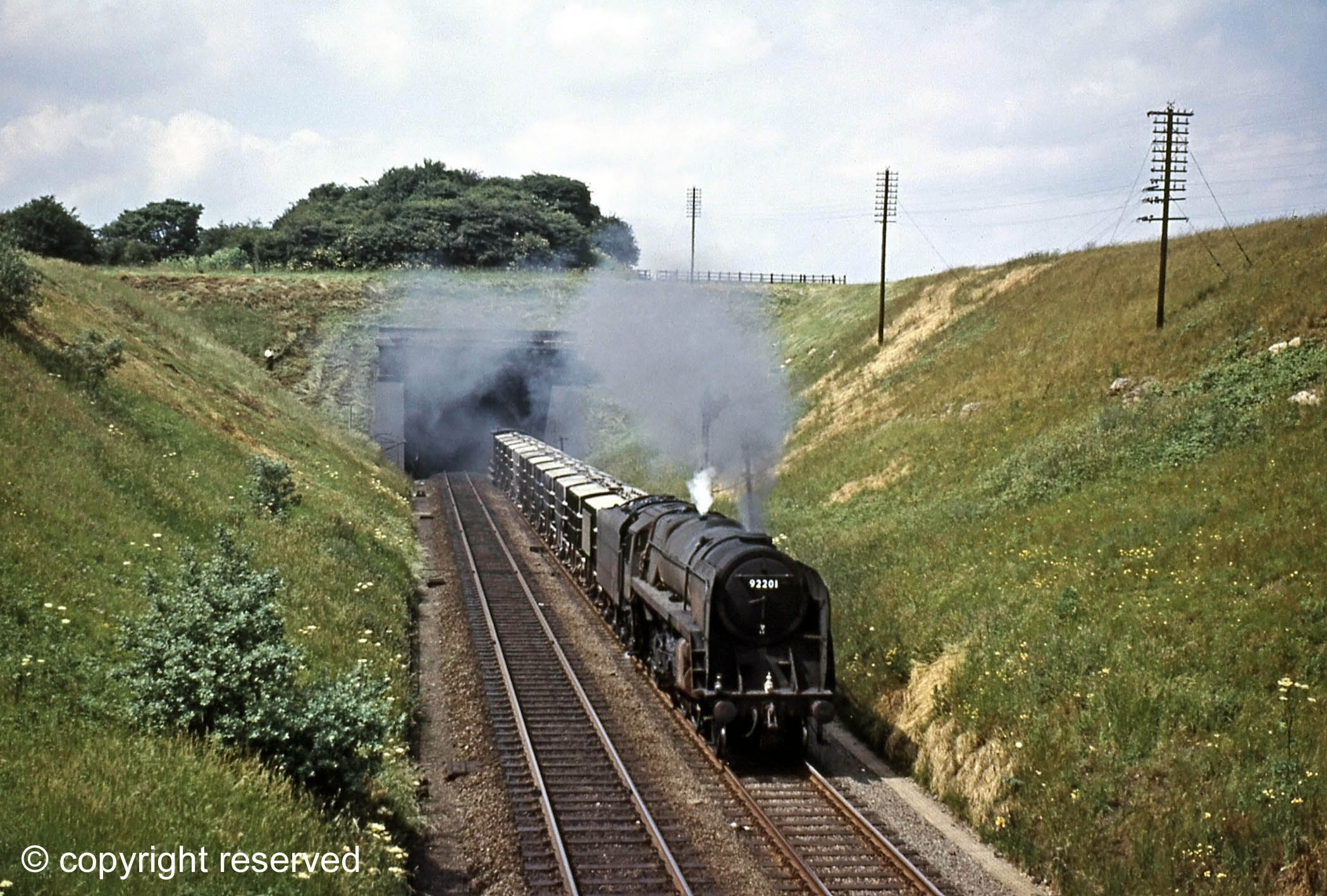
The line of poles on the right carry the railway's telegraph and telephone links above the tunnel, including the block telegraph system connecting Stoke box with Highdyke box. There is a connection from the nearest pole down to the distant signal; this actuated an instrument in Stoke box to inform the signalman if the signal developed a fault.
The photographer had climbed the Down Main advance starting signal post (which appears in the next photograph) to achieve this shot.
Photograph taken by Noel Ingram.

Above the first coach is the Down Main line advance starting signal of Stoke box, with the yellow distant signal for Highdyke beneath. The signals are offset over the line on a bracket for better visibility, because the approach is on a left hand curve.
Photograph taken by Noel Ingram.
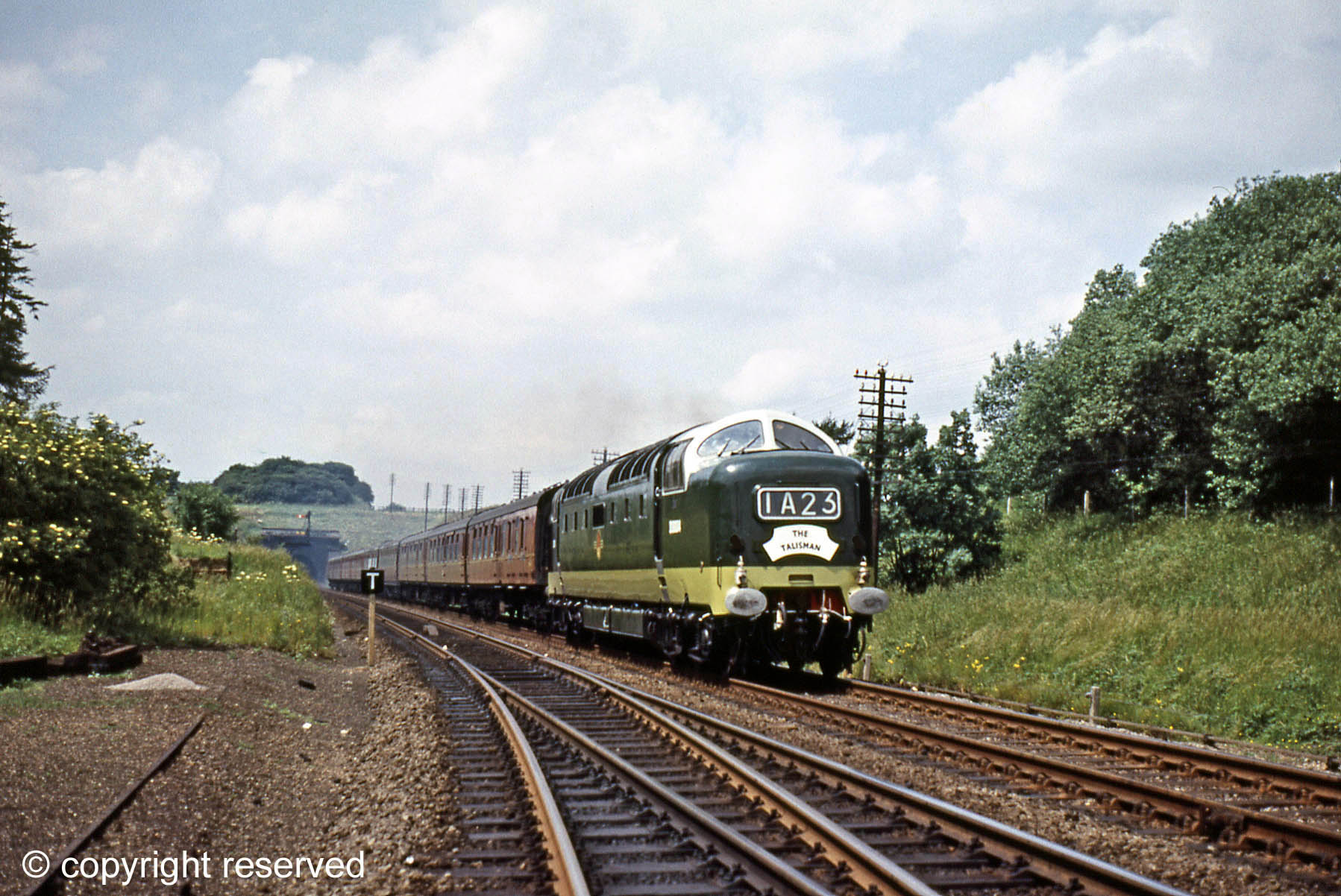
In the foreground the Down Goods line converges with the Down Main line. The white 'T' indicates the termination of a temporary speed restriction in the Down direction.
Photograph taken by Noel Ingram.

There is another train signalled towards the tunnel on the Down Main line. The line on the left is the Down Goods which converges with the Down Main at this point. The trap points on the left are set to divert any overrunning train on the Goods line away from the main line and into a short dead-end siding with a sand drag (the rails run through a bed of sand) to retard its progress.
Photograph taken by Noel Ingram.

The box is hidden by the train, but its tall chimney is visible above the front of the first coach. The locomotive is framed by the Up home signal, indicating a choice of route opposite the box: left for the Up Goods and straight on for the Up Main.
Photograph taken by Noel Ingram.

Photograph taken by Noel Ingram.

On the left, a train of mineral wagons is held on the Down Goods line because the Down Main starting signal in the far distance is 'off' for an overtaking train. Steam from the locomotive waiting with the mineral wagons rises behind the first coach of the express.
Photograph taken by Noel Ingram.

Photograph taken by Noel Ingram.

The outline of the box can be seen ¾ mile away, while in the cutting stand three signals: the Down Goods distant on the left and the Up Main and Up Goods starting signals (the latter hidden by its square sighting board).
The lines ascend here at a gradient of 1 in 178 from Corby Glen, 3 miles south. It's the steepest section of Stoke Bank, whose summit is marked by the box. On this stretch of line the front of a 12-coach train ascending the bank will be 4 feet higher than the rear coach.
With no trains to distract the eye one has to admire the neat and tidy condition in which this dead straight section of railway was kept by the local permanent way gang, who were based in the hut on the left. On the right it appears that a drainage ditch has been provided just inside the railway boundary to stabilise the side of the cutting by diverting rainwater runoff from adjacent land.
Photograph taken by Noel Ingram.
Back to Signalling and Signal Boxes


What a wonderful series of photos of this rarely seen box (cabin!).
Thanks for sharing them.
An excellent and very valuable addition to the website, especially the photographs inside the Box. A lonely place to work if it was not such a busy line!
Phil and Humphrey - many thanks for leaving such appreciative comments. I'm sure Derek will be pleased to read them too. It was a very interesting page to put together.
Just recently a collection of photographs has been made available to us at 'Tracks through Grantham' which includes a number of new views at Stoke summit. So we'll be in a position to refresh the page with some more photographs in a few months' time.
John Clayson.
What a wonderful series of images and details about this box. I spent some time there in the sixties photographing trains, but looking back, very few actually show the box! All my shots are black and white, so good to see these colour pictures. We had cups of coffee made for us by the then signalman, Pete, IIRC. We had walked from Great Ponton box and over the tunnel to get there so the coffee was very welcome!
A great set of photos. One thing which particularly interests me is how close the Up distant was to the Home signal, there must have been totally inadequate braking distance, it can't have been more than 300-400 yards. I guess they got away with it steam days as speeds would be low exiting Stoke tunnel after breasting the bank but it does make you wonder why it wasn't moved back to the Grantham side of the tunnel. The later photo of the box diagram, after the semaphore had been abolished and replaced by a colour light, shows that latterly this is exactly what they did, using Highdyke's advanced starter to act as distant. I suspect it started to become a real issue once diesels came onto the scene. You can also see the same thing with the Down Goods Distant, but I suspect speeds were low on the Goods so it wasn't such an issue.
Hello Andy,
Thanks for your feedback. I've checked some photographs and in the semaphore era, so far as I can see, there's no Up distant for Stoke on the north side of the tunnel. Certainly the gantry at Highdyke carried no distant arms for the Up direction. I wonder if there was a local arrangement in place between Highdyke and Stoke before the change to colour light signals to prevent, or reduce, the likelihood of a train exiting the tunnel at speed being faced with adverse signals at Stoke? I will ask around.
John Clayson
This is a very fascinating series of photos and descriptions. It takes me back to the summers of 62/63 when I was at Knebworth but unfortunately did not have a camera. It is so interesting to see what was further up the line as at the time I could only imagine, and I wonder if anybody took a series of photos of Knebworth like the ones of Stoke Summit.
Thank you very much.
Came across this article while looking up Stoke Tunnel, very interesting indeed.
Hello Ian. We're glad you found Tracks through Grantham of interest, and thanks for letting us know.
John Clayson
Fascinating set of photos and descriptions. Came across this by chance. A very pleasant half hour spent.
Hello John,
Thank you for getting in touch. We're delighted to hear that you enjoyed our page about Stoke box. We count ourselves very fortunate that on Tracks through Grantham we have the support of many contributors. The Stoke box page is a particularly fine example of memories and images generously provided independently by several people which we have been able to draw together.
Kind Regards,
John Clayson
Fascinating and interesting pictures. I have often wondered how the speed record took place and exactly where. Thank you for these pictures.
Hello Paul,
Thank you very much for your kind comment about our page on the signal box at Stoke. We're pleased you enjoyed reading about the box and its place in Grantham's railway history.
Best wishes,
John Clayson
This page is proving an invaluable resource for researching this section of the line as, along with help from fellow members of the East Grinstead Model Railway Club, I am just starting to build a model of this location and Corby Glen station and shall be constantly visiting to restudy and also read the other pages.
Kind Regards,
Adrian Harrison
Were there any other occasions when a locomotive topped 100mph on the racing stretch down to Tallington?
Hello Graham,
Thank you for your comment. We're sure there were many times that 100mph has been exceeded by a steam locomotive between Stoke summit and Tallington. Several of these occasions have been officially recorded, such as with A4 No. 60007 on 23rd July 1959 (112mph) and 6th July 1963 (103mph) (see this page and scroll down to those dates). On this page of the Tracks through Grantham website Roy Vinter describes how Grantham footplate crew would quite often aspire to beat 'the ton', given the opportunity.
John Clayson